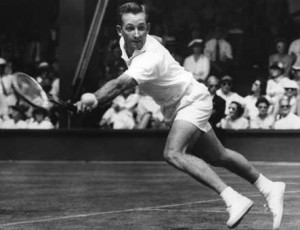Hitting a good volley is like punching someone in the nose – at least that is the gospel from Rod Laver, who executed the stroke to near perfection while becoming the only player in the history of tennis to win the Grand Slam on two occasions (1962, 1969). In his updated and re-released autobiography THE EDUCATION OF A TENNIS PLAYER, Laver outlines many tennis tips to help amateurs – and pros – improve their games, including the key to hitting a crisp volley.

Written with Hall of Fame journalist and historian Bud Collins, THE EDUCATION OF A TENNIS PLAYER is Laver’s first-hand account of his famous 1969 Grand Slam season, capped off by his win over fellow Australian Tony Roche in the final of the U.S. Open. Laver also writes about his childhood and early days in tennis, his 1962 Grand Slam and offers tips on how players of all levels can improve their game. He also shares some of the strategies that helped him to unparalleled success on the tennis court.
Originally published in 1971, THE EDUCATION OF A TENNIS PLAYER ($19.95, www.NewChapterMedia.com) was updated by Laver and Collins with new content including his recovery from a near-fatal stroke in 1998 and helping Australia once again win the Davis Cup in 1973. The memoir features descriptions of Laver’s most suspenseful matches and memorable portraits of his biggest rivals Ken Rosewall, Lew Hoad, Tony Roche and Pancho Gonzalez.
Laver’s full tip on hitting a crisp volley is excerpted below…
A good punch in the nose—that’s the volley. A short, stiff jab with almost no backswing. You’re blocking the ball, not stroking it.
The wrist is firm and below the racket when you punch, and you use the pace from your opponent’s shot—if it’s a good shot. Occasionally when a shot sits there weakly to be volleyed away you have to supply a little of your own power.
By keeping your eye on the ball intently and blocking it you can become a pretty good volleyer and a terror at an ordinary level. There is more to it than that as you progress. You will want to level the racket slightly so that you are hitting slightly under the ball to create a slice or underspin. This gives you more control.
Then there’s footwork, without which you can’t become a really fine volleyer. As you jab with your racket you’re also taking a jab step into the ball. A right-hander steps in with his left foot for a forehand volley and with his right foot for a backhand. This insures that you’re hitting the ball out front where a good volley must be hit. That step is going to put more impact into your punch so that the volleys will gain length and fly to the corners and the baseline. Remember: you don’t need backswing to give you depth. Meeting the ball out front with your body moving behind that jab step will do it.
To take the step you have to be side-on to the net. Not always possible in a fast match. Frequently you’ll be caught head-on to the net. Then you pivot at the hips, like a baseball catcher who has to rush a throw to second base from his haunches. “Wrong-footing” was a favorite tactic of Kenny Rosewall, and it’s a good one for the volleyer once he feels he has control of the stroke. Wrong-footing is hitting to the place your opponent has just vacated, or will vacate to cover the next logical shot. He’s gone to his left corner, say, to return your shot and then he dashes to his right to cover the wide opening. You wrong-foot him by volleying right back to that left corner, and if your timing is right he can’t change directions to go back for the ball. But if you aren’t accurate it will backfire because you may hit the ball right back at the fellow, not behind him.
Rosewall liked to do this especially with his backhand. You hit a crosscourt shot and he got his backhand volley on it, and rather than place it in the open corner he came straight back at you with the angle, and this beat an awful lot of good players. If they can spin around and get to the ball they won’t do much with it and Kenny had a setup on the next shot.
When the ball is below the level of the net you’re going to have to bend to get down to it. The ideal is still to keep the wrist below the racket. This will help you keep your volleys low, even the defensive volleys. If you don’t bend and stay low you’re going to pop your volleys up, and that’s when the other guy gives you a punch in the nose with his volley.
